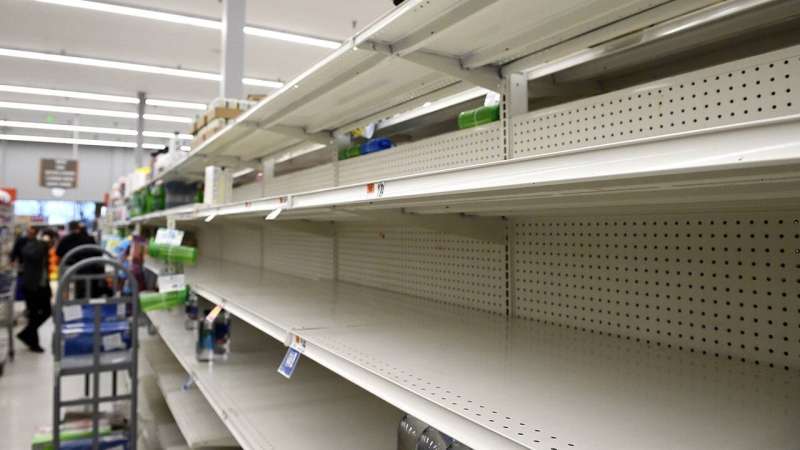Credit: Will Kirk / Johns Hopkins University
Times of crisis can bring out the best in people. It can also reveal the strangest parts of human nature.
While restaurants in six states are offering free toilet paper to those in need in response to the barren toilet paper shelves in many local grocery stores, U.S. Today reports that a police department in Newport, Oregon, issued an urgent request for residents to stop calling 911 when they run out of toilet paper. "You will survive without our assistance," the department stated.
Meanwhile, as the New York Times reports young people are continuing to travel despite restrictions and state and local governments are closing businesses to prevent people from congregating in public, groups of older adults, including an enclave of retirees in Florida and the parents of one New Yorker writer, are largely resisting the very social distancing behaviors that may protect their health.
Why?
"This outbreak is a classic example of a social dilemma," says Stephen Drigotas, a teaching professor and co-director of undergraduate studies in the Department of Psychological and Brain Sciences at Johns Hopkins. He is an expert in social psychology, and he says he'll likely draw from these news reports for material to include in his introductory course.
In the case of people panicking about toilet paper shortages, there are two phenomena in play, Drigotas explains.
First, panic buying during a pandemic is a classic example of a social dilemma: an inherent conflict between a person's individual self-interest and the good of the group as a whole. In this case, stockpiling goods is an example of the commons dilemma, which is based on 19th-century accounts of farmers who overgrazed public land set aside for their use by the government. Farmers could bring as much livestock to graze as they wanted, but many farmers came too often or with too many animals, and soon the land was stripped, requiring a season of no grazing in order to regrow and replenish.
"For an individual farmer, the dilemma was that they wanted to maximize the amount of grazing for their herd and ensure their livestock were all well-fed, but if too many farmers acted that way, the resource would be depleted for everybody," Drigotas explains.
During this outbreak of COVID-19, he says, common resources like food, toilet paper, and other essentials can become depleted if people don't show restraint.
"The problem occurs when people start to think that they're the ones sacrificing or missing out and they see other people benefiting," Drigotas says. "It inherently changes their mindset, and they'll actually start to feel that they're being taken advantage of. It causes people to react—panic might be a strong word—but it changes their motivation to become more selfish or overestimate what they need. In this case, it's toilet paper, of all things."
Another element at play is called the law of scarcity, which relates to how consumers think about goods that are in limited supply or available for a limited time, Drigotas says. Marketers will often use that sense of urgency to inspire people to make purchases they otherwise wouldn't. People are especially susceptible to the law of scarcity when they don't put much cognitive energy into their decision making, such as during late-night infomercials, or during a stressful, last-minute trip to the grocery store.
The challenge here, Drigotas explains, is inspiring people to resist the influence of the law of scarcity on their thinking and practice restraint in their purchasing.
"The more messages that get out there about how we should behave and how we should respond to this dilemma of the coronavirus outbreak, the more we'll understand that practicing restraint is the right thing to do," Drigotas says. "Moreover, if you can see evidence of other people showing restraint, people will be more likely to say yes, we can all work together in the face of this crisis."
Important groups of people may be ignoring these key messages about restraint, however. Business Insider reports that millennials are "snapping up" inexpensive flights despite travel warnings from the U.S. State Department and Centers for Disease Control and Prevention.
Drigotas says a fair amount of these behaviors can be chalked up to the recklessness of youth, but there may be another phenomenon at work here. "The probability is that if you're young, you aren't likely to experience poor outcomes from contracting this disease," he says. "I suspect that as we start to see more evidence of how this disease affects people and younger people start knowing people who get infected, they will start to show a little more restraint in their actions."
But paradoxically, media reports have also emerged indicating that many baby boomers are unwilling to cancel cruises or practice social distancing measures despite being at higher risk of developing severe illness if they contract COVID-19.
"Humans aren't good at doing probability estimates," Drigotas says. "There may be a mindset within this population that contracting COVID-19 is high consequence but low probability. For young people, the estimate would be that contracting COVID-19 is high probability but low consequence. This could explain why these two groups might eschew social distancing measures."
Drigotas cautions that it's not clear yet how statistically relevant these reports about baby boomer and millennial behaviors are—there's still much to learn and study, he says. He plans to continue to monitor the outbreak and look for evidence of the principles of social psychology at play, but he, like his Johns Hopkins colleagues, will be doing it from the comfort—and safety—of his home.
Provided by Johns Hopkins University
























